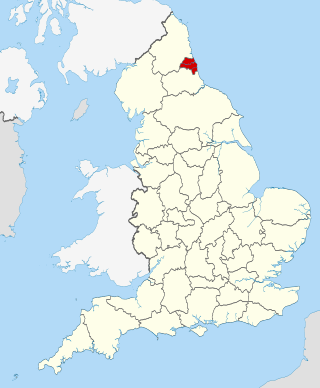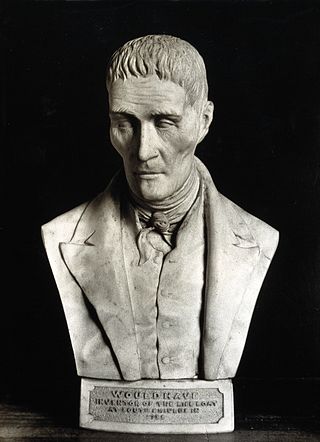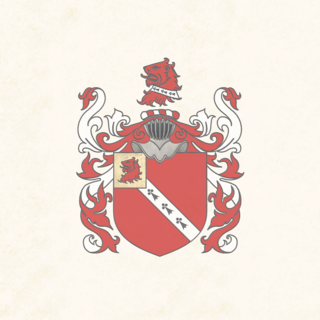Related Research Articles

Tyne and Wear is a metropolitan county in North East England, situated around the mouths of the rivers Tyne and Wear. It was created in 1974, by the Local Government Act 1972, along with five metropolitan boroughs of Gateshead, Newcastle upon Tyne, Sunderland, North Tyneside and South Tyneside. It is bordered by Northumberland to the north and Durham to the south; the county boundary was formerly split between these counties with the border as the River Tyne.

William Wouldhave (1751–1821) is a rival of Lionel Lukin for recognition as inventor of the lifeboat. His tombstone describes him as:

The North Eastern Railway (NER) was an English railway company. It was incorporated in 1854 by the combination of several existing railway companies. Later, it was amalgamated with other railways to form the London and North Eastern Railway at the Grouping in 1923. Its main line survives to the present day as part of the East Coast Main Line between London and Edinburgh.

Tynemouth is a constituency in Tyne and Wear represented in the House of Commons of the UK Parliament since 1997 by Sir Alan Campbell, a member of the Labour Party.
Sir William Blackett, 1st Baronet was a businessman who founded a mercantile and industrial base in Newcastle and a politician who sat in the House of Commons from 1673 to 1680.
Newcastle-upon-Tyne was a parliamentary borough in the county of Northumberland of the House of Commons of England from 1283 to 1706, then of the House of Commons of Great Britain from 1707 to 1800 and of the House of Commons of the United Kingdom from 1801 to 1918. It returned two Members of Parliament (MPs), elected by the bloc vote system.
The Ogle family were prominent landed gentry in Northumberland, England. The earliest appearances of the family name were written Hoggel, Oggehill, Ogille and Oghill.

The Milbanke, later Noel, later Milbanke Baronetcy, of Halnaby in the County of York, was a title in the Baronetage of England. It was created on 7 August 1661 for Mark Milbanke. His father was Mark Milbanke of Chirton, Northumberland a Newcastle on Tyne merchant and hostman who was Sheriff of the city in 1638, and Mayor in 1658 and 1672, and whose marriage brought him an estate at Halnaby, near Darlington, North Yorkshire. The second Baronet was High Sheriff of Northumberland in 1678. The third Baronet was High Sheriff of Northumberland 1685 and Member of Parliament for Richmond. The fifth Baronet was Member of Parliament for Scarborough and Richmond. The sixth Baronet sat as Member of Parliament for County Durham. He married Judith Noel and changed his surname in 1815, but he died leaving only a daughter, Annabella, who married the poet Lord Byron, and so he was succeeded by his nephew. The tenth Baronet was awarded the Victoria Cross. The title became extinct on the death of the twelfth Baronet in 1949.

The Tempest family was an English recusant family that originated in western Yorkshire in the 12th century.
John Clarke, also known as John Clark, John Clerk, and John Clerke, was an English politician and Justice of the Peace who sat in the House of Commons from 1653 through 1660, and was a colonel in the Parliamentary army between 1651 and 1659.

Richard Gilpin (1625–1700) was an English nonconformist minister and physician, prominent in the northern region.

Sir Richard Edgcumbe was an English politician.
Captain Sir Thomas Liddell, 1st Baronet (1578–1652) was an English politician, a member of the Liddell family which monopolized the local government of the North of England during the 16th and 17th centuries. He was one of the leading supporters of the Royalist cause in the English Civil War.
Robert Scawen (1602–1670) was an English politician who sat in the House of Commons at various times between 1640 and 1670. He supported the Parliamentary cause in the English Civil War.

Chirton Hall or Chirton House, occasionally spelled Churton and originally Cheuton, was a country house in Chirton, in what is now a western suburb of North Shields, Tyne and Wear, North East England. Historically, the house was in the county of Northumberland.
Philip Bickerstaffe (1639–1714) was an English merchant and the owner of Amble Works. He was M.P. for Berwick-upon-Tweed 1685; and for Northumberland 1689-1698. He descended from the family of Bickerstaffes, of Bickerstaffe, Lancashire. Although he opposed the transfer of the Crown to the Prince of Orange in 1668-69, he was re-elected for the next parliament of 1669-90.
Jeremiah Tolhurst (1615–1671) was an English tailor, soldier, businessman and politician who sat in the House of Commons at various times between 1654 and 1660. He fought in the Parliamentary army in the English Civil War.
William Weaver Tomlinson, historian, is known for his histories of the north east of England, in particular for his Comprehensive guide to the county of Northumberland. (1888) and his history of the North Eastern Railway: The North Eastern Railway; its rise and development, published 1915.
William Bigge (1707–1758) was an English lawyer, landowner and colliery owner.
Bertram Anderson was an English merchant, landowner and politician who represented Newcastle-upon-Tyne and served once as Sheriff, three times as Mayor and was elected five times as MP in the House of Commons between 1553 and 1563 and was also Governor of the Merchant Adventurers of Newcastle-upon-Tyne.
References
- 1 2 3 4 "Clarke, John II (d.1675), of Chirton, Northumb". The History of Parliament Trust. 1983. Retrieved 25 November 2011.
- ↑ Northumberland County History Committee (1907). A history of Northumberland. A. Reid, Sons & Co. pp. 2, 241, 322. Retrieved 21 November 2011.
- ↑ Tomlinson, William Weaver (November 1968). Tomlinson's comprehensive guide to Northumberland. David & Charles. p. 410. Retrieved 21 November 2011.
- ↑ Reprints of rare tracts & imprints of ancient manuscripts, &c: chiefly illustrative of the history of the northern counties. Printed at the press of M.A. Richardson. 1849. p. 24. Retrieved 21 November 2011.
- ↑ Bean, William Wardell (1890). The parliamentary representation of the six northern counties of England: Cumberland, Durham, Lancashire, Northumberland, Westmoreland, and Yorkshire, and their cities and boroughs. From 1603, to the general election of 1886. With lists of members and biographical notices (Public domain ed.). Printed for the author by C. H. Barnwell. pp. 487–. Retrieved 27 November 2011.
- ↑ Hayton, D. W.; Cruickshanks, Eveline; Handley, Stuart (October 2002). The House of Commons: 1690-1715. Cambridge University Press. pp. 209–. ISBN 978-0-521-77221-1 . Retrieved 27 November 2011.